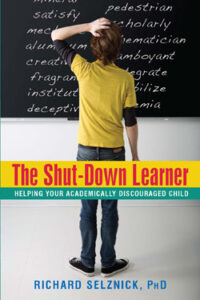 OK… Among other disorders that I seem to have, readers of this blog know I have confessed to my “PBD” or “Pushback Disorder.”
OK… Among other disorders that I seem to have, readers of this blog know I have confessed to my “PBD” or “Pushback Disorder.”
PBD usually manifests whenever parents tell me something that has a hypothesis (i.e., an opinion) as to why their child is doing or not doing something.
Usually, there is some type of disorder attached to the hypothesis.
Some examples include:
- “My child is sensory seeking.”
- “My mother’s uncle has clear ADHD and it runs in the family, so I see it coming out with our 7-year old when she refuses to do her homework.
- “Emotional self-regulation is challenging for William – he always demands to be first in everything.”
- “Her dyscalculia is running rampant – she just can’t do math word problems.”
- “George hates reading so much – all he can focus on are video games. I think his dyslexia trips him up and he escapes to video games for safety.”
While all of these hypotheses may be true to a greater or lesser degree, ultimately they are opinions, guesses as to what’s going on.
Even with decent testing, there’s still guesswork involved with “the diagnosis,” which leads to another of my numerous disorders.
I haven’t seen it in the research literature, so I may be the first person to discover it – I am calling it “Hemming and Hawing Disorder” or “HHD.”
“HHD” manifests in my corner of the universe around questions of ADHD, Dyslexia, Anxiety and Asperger’s, among others, for example.
Recognizing that there is no definitive test for any of these commonly raised concerns, I often find myself “hemming and hawing” after I’ve done a hefty dose of pushing back.
HBD is correlated highly with “Squeamish Disorder” (SD), which I freely own.
Not being a neurologist (who must have steelier nerve than I have with much more science behind them), I am uncomfortable saying that I child has a neurological disorder.
What I am not squeamish about, however, are stating facts that emerge in an assessment: .
For example:
“The fact is your child rushes through tasks.”
“Your child has a significant reading, spelling and writing problem and is well below the norm on these skills.
“Your child has superior visual intelligence, but is much weaker with verbal skills which are likely to impact things like reading comprehension or understanding lectures.”
“Following directions is very difficult for your child which came out in many of the portions of the testing.”
“Clear deficits with reading rate, accuracy and fluency were seen on all of the tests.
Takeaway Point
I clearly need help with all of my numerous disorders, such as PBD, HHD and SD, among others, however, stating the facts clearly keeps these disorders at bay.
For statements like these, I don’t show any HBD or SD.
***Please note: All blogs represent the opinion and perspective of Dr. Richard Selznick. Comments and questions are welcomed, but are blocked by the hosting site. Please email questions or comments: rselznick615@gmail.com)
 Copyright, Richard Selznick, Ph.D. 2022, www.shutdownlearner.com.
Copyright, Richard Selznick, Ph.D. 2022, www.shutdownlearner.com.
To Contact Dr. Richard Selznick for advice, consultation or other information, email rselznick615@gmail.com.
To receive future blog posts, register your email: https://shutdownlearner.com.

 In my ongoing education, this week I learned about the “Barn Kids” and the “Populars.”
In my ongoing education, this week I learned about the “Barn Kids” and the “Populars.”
